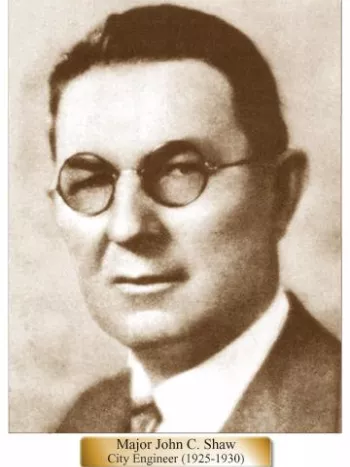
Major John C. Shaw, a native of Tunnelton, West Virginia, where he was born in 1877, came to Los Angeles in 1919.
As a young man he was a soldier in the American Army in both the Spanish American War and World War I.
A Los Angeles Harbor Engineer and a Member of the County Flood Control Board for several years, he served as City Engineer from 1925 to 1931.
During his tenure, 974 miles of permanent street paving were constructed, about 55% of permanent street paving in Los Angeles at that time. Streets paved included major traffic arteries such as Wilshire Boulevard, Pico Boulevard, Slauson Avenue, Florence Avenue, La Brea Avenue, Angelus Mesa Drive, Vermont Avenue, San Fernando Road, Cahuenga Pass, Riverside Drive, Glendale Boulevard and Los Feliz Boulevard.
Also nearing completion while he was engineer was Ventura Boulevard and South Sherman Way, the latter being the first paved Highway over the Santa Monica Mountains. Sepulveda Boulevard, under Sepulveda Tunnel, was under construction during his time as engineer.
Also built during this period were 285 miles of storm drains, 1,459 miles of sanitary sewers, 44 pedestrian tunnels and viaducts over Anaheim Street, Macy Street, First Street, Spring Street, Dayton Avenue, Fletcher Drive and Glendale Hyperion. Several small bridges and grade separations were built, the principal ones being Fourth and Lorena, Myra Avenue and Sunset, Waverly and Hyperion, San Vicente and Pico, San Vicente and La Brea, and La Cienega.
As a Spanish American War Veteran, he was an active member in veteran's activities (Roosevelt Camp) up until he retired because of ill health in 1937. He died in 1943.
During his tenure as City Engineer, specifically in 1928, the present City Hall was opened and Congress passed the Boulder Canyon Act calling for construction of what was to be Hoover Dam on the Colorado River which would one day give Los Angeles more power and water.
Sources:
Los Angeles Chronicle
Los Angeles Times
Municipal Reference Library